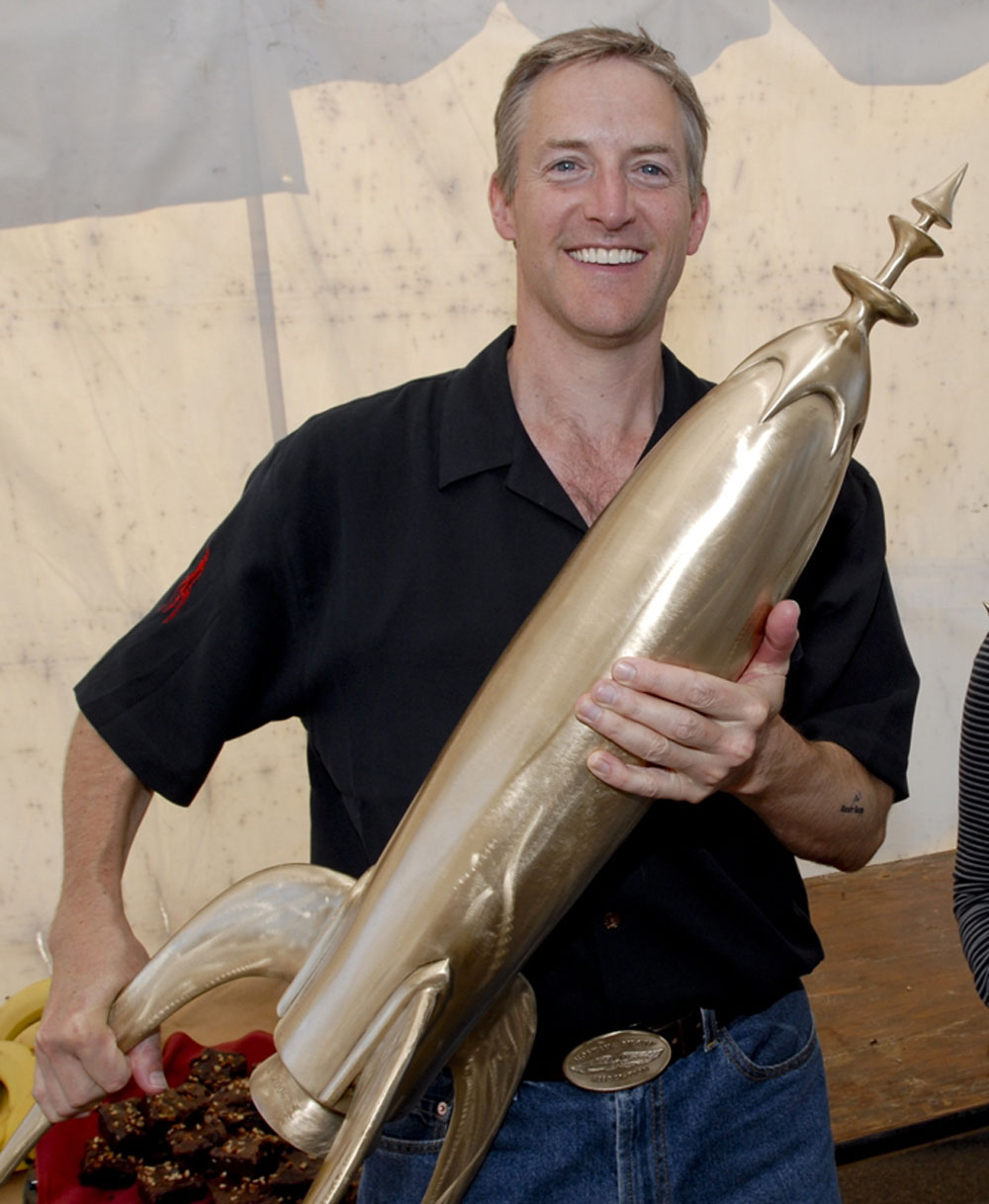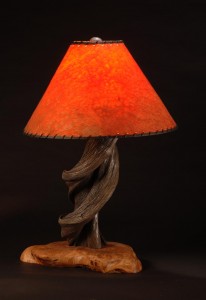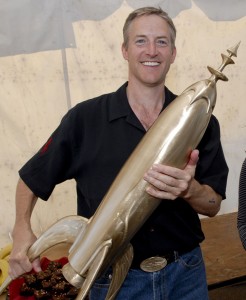
Inspired by science fiction serials, Erik Lindbergh’s rustic rockets have become some of his most popular creations.
By Clayton Moore
It takes a lot of mettle to live up to being Charles Lindbergh’s grandson, and Erik Lindbergh happens to have plenty of it. His creative energies are infused with the freedom, imagination and perpetual motion his spirited grandfather experienced in the aviation world. Like his grandfather, Erik Lindbergh is a pilot; he’s also an acclaimed artist, sculptor and woodcarver. His furniture and artwork flow with the same fusion of nature and science that his grandfather encouraged.
“Some people see things in clouds,” he says. “I see things in wood.”
Art is only a part-time occupation, as Lindbergh works hard to balance his talents with his responsibilities as the newly chosen chairman of the Lindbergh Foundation. He’s also heavily involved with the X PRIZE Foundation and pursues many other philanthropic enterprises. He balances that heavy workload with artistic endeavors he feels are essential to his physical and emotional well-being.
Growing up in public
Growing up in the shadow of an aviator like Charles Lindbergh can’t be easy for the heartiest of people. Erik Lindbergh managed not only to survive but also to triumph, after he finally embraced his rich heritage.
He was born in 1965 to Jon Lindbergh and Barbara Rollins in California, but grew up on picturesque Bainbridge Island, one of the larger islands in Puget Sound, off the coast of Washington. The sports-oriented youth won the all-around state gymnastics championship at 12 and pursued water-skiing, mountain climbing and telemark skiing with equal vigor. What he didn’t pursue at the time was art.
“I never really thought I had much artistic sense as a young man,” Lindbergh recalled. “I couldn’t really draw anything, and my clay figures were crude. I never thought I had it, compared to all these kids who could draw great dinosaurs.”
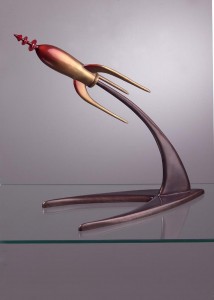
Desktop Rocket” is a perfect accessory for aviation-minded executives who might want to spend a few minutes daydreaming.
Lindbergh graduated from Bainbridge Island High School in 1983 and joined the “family business,” earning a pilot’s license and becoming a flight instructor. His first artistic pursuits came during a summer spent instructing pilots at Jefferson County International Airport in Port Townsend, Wash.
“During college, I rented a house on the beach for the summer,” he said. “On long walks, I started seeing things in the driftwood that would wash up. I saw mostly furniture. I’d see a significant piece of driftwood, and suddenly in my mind, it was a chair or a table or some other incredible piece.”
Lindbergh started collecting driftwood, but didn’t construct his first piece until 1991.
“The first thing I made was a bench,” he remembered. “It was a beautiful piece of maple driftwood that looked like a wishbone. I split it to make two wishbones, and the ‘Y’ of the wishbones formed the legs. I had a slab of redwood for the seat that I morticed in and used another piece of driftwood for the back. It made a wonderful bench.”
Lindbergh made several more pieces of furniture, but it was a sculpture that allowed him to finally face his family tradition.
Evolution of spirit
Although he had always been involved with his family’s foundation, the younger Lindbergh wasn’t too enthusiastic about being a Lindbergh back in those days.
“I hadn’t really gotten through it, or past it, at that point,” he said. “I was still at a stage in my life where I was trying to avoid things that were too ‘Lindbergh.’ It was too intense of a legacy for me to think about. The burden is very heavy at times.”
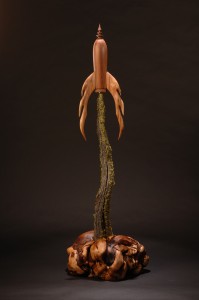
“Escape from Grey Matter” is made from cedar, dogwood, and “lichened pine toot,” with the grey matter, the artist jokes, made of “unobtainium.”
He was content to sell his furniture at the local farmer’s market on Bainbridge Island. One day, a customer, who knew of Lindbergh’s talent and family tree, asked him to carve something unique.
“He had ordered a bunch of furniture made from a tree he cut down on his property,” Lindbergh remembered. “He asked if I would make a model of The Spirit of St. Louis for his brother as a birthday gift. I told him he could buy that sort of thing out of a magazine, but he said, ‘No, I want your rustic style: something that has character and is evocative but not perfect.’ He said both he and his brother were FedEx pilots, and that they had been inspired to start flying by my grandfather’s flight across the Atlantic.”
Lindbergh eventually softened to the idea and started quietly working on a model of the aircraft.
“As I started making this thing, in my own funky style, I started thinking about what the flight must have been like for my grandfather,” Lindbergh said. “The waves of grain in the wooden wing of my sculpture reminded me of waves on the ocean, the swells of the Atlantic. The Spirit of St. Louis is such a unique aircraft. As it came together, I started flying it in my hands around the shop, looking at it from different angles and putting myself, in my mind’s eye, into the cockpit. What was that like—this flight that changed not only my grandfather’s life, but also changed aviation and the world at large?”
Lindbergh is just the sort of person to try to answer that question.
A type of therapy
Lindbergh has certainly had his own challenges. The energetic athlete faced a devastating diagnosis at just 21 years old: rheumatoid arthritis, a progressive autoimmune disease marked by pain, tenderness and inflammation of the joints. The disease forced him to give up flying for more than six years. During a decade that found him nearly crippled by the disease, he found his work as an artist to be extremely therapeutic, and still does today.
“It’s been a challenge physically to do hours and hours of sanding or chiseling,” he admitted. “But it’s also been a tremendous benefit for me. ‘Making sawdust’ helps keep me grounded, because it really is a calming, creative outlet. It’s challenging and I have moments of agony, but it’s also very satisfying to finish a piece. Then I get to take it to a customer, who’s very happy and inspired by what I’ve created with my own two hands.”
Lindbergh had to use a cane for several years, as his joints became more and more tender. Finally, in 1996, he had both knees replaced with titanium and plastic, which helped him become more mobile. Some time later, Enbrel, a breakthrough biotechnology drug, radically improved his physical well-being.
“It really gave me my life back,” Lindbergh says of the medicine.
Today, he serves as a spokesman for the Arthritis Foundation, helping others cope with the challenges of rheumatoid arthritis.
The “New Spirit”
Buoyed by his physical improvements and a healthier state of mind, Lindbergh finished his “The Spirit of St. Louis” sculpture and began contemplating something more ambitious.
In 2002, the year of the 75th anniversary of Charles Lindbergh’s historic transatlantic flight, Erik Lindbergh retraced his grandfather’s route. Leaving from Republic Airport on Long Island in The New Spirit of St. Louis, a Lancair Columbia 300, he landed at Le Bourget Airport in Paris on May 2, 2002. He made the flight in 17 hours and 7 minutes—almost twice as fast as his grandfather. Today, Lindbergh feels that making the flight has made him a better man.
“It was a rite of passage,” he said. “You could equate it to slaying a lion with a spear, if you were a Masai warrior; it’s how you come of age. It allowed me to walk in my grandfather’s footsteps but not have to fill his shoes. It was also a turning point in my life, because previously, it had been taboo to have anything to do with his legacy—especially the flight, the achievement for which he was best known.”
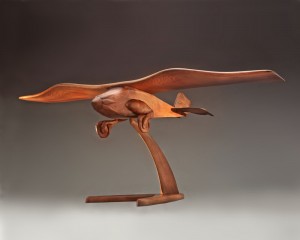
“Evolution of Spirit” is Lindbergh’s favorite sculpture, evoking the romance of his grandfather’s historic transatlantic flight.
Beyond the physical challenges of training for the flight (Lindbergh’s preparation included sea survival exercises and intensive flight instruction), he also had delicate family matters to confront.
“I have a very intelligent and opinionated family, and I had some difficulty with upset family members, but they more or less came around,” Lindbergh said. “I think it helped free some of the family from the burden of that legacy. It definitely freed me and enabled me to go forward and use that legacy.”
He has more responsibilities now. Besides being the chairman of the Lindbergh Foundation and an active board member of the X PRIZE Foundation, he’s one of four founding members of the Rocket Racing League and is a founding board member of the Aviation High School in Seattle. He also does public relations work for Columbia Aircraft and engages in public speaking regularly, sharing stories about his grandfather’s legacy and his own triumphs over adversity.
“I get excited about things, and I like to talk about them,” he said. “Speaking engagements are a way for me to reach people and inspire them to use their own energies in a positive way: to push their boundaries, push the envelope and expand their potential.”
He also has a new initiative in the works but isn’t quite ready to reveal his plans publicly yet.
“I don’t want to work on projects that don’t generate some kind of positive change,” Lindbergh explained. “I use that as the acid test, a way to measure how I’m spending my lifetime. This new project is focused on creating that change in a big way.”

In 2002, Erik Lindbergh celebrated the 75th anniversary of Charles Lindbergh’s famous flight across the Atlantic by repeating the journey in a Lancair Columbia 300.
The Lindbergh Foundation remains his most serious responsibility and the instrument through which Lindbergh is able to utilize much of his own energy and influence.
“The Lindbergh Foundation is the biggest priority in my professional life,” he said. “I took the position of chairman of the board this year. It’s a world-class institution, but we’ve never done much marketing or fundraising, which could raise our public profile. We want to take these concepts that stem from my grandfather’s legacy and leverage the foundation as a household name.”
In many ways, his ambitious efforts mirror his grandfather’s extraordinary life.
“Flying across the Atlantic really helped me to realize that I only have so much life,” he said. “I’ve already had one second chance, and I don’t know if I’ll get a third. I need to do what I need to do, right now. My grandfather spent a tremendous amount of energy using his fame to try to create positive change in the world. Completing the flight made me realize that it’s important for me to use that legacy to create positive change in my own time.”
The allure of wood
Despite his many professional responsibilities, Lindbergh is able to maintain a small studio attached to his home on Bainbridge Island, where he continues his work as an artist. He recently contributed several pieces to an exhibition called “Nudes and Foods,” at the nearby Island Gallery, and has branched out far from his original furniture. The draw, however, remains the attraction of unusual wood, and the hard work that transforming it requires.
“I just read something about how the Japanese revere wood for its properties—the texture, the feel, the look,” Lindbergh said. “I think some people really respond to wood, as a natural substance that has a tremendous amount of inherent character. I’ll never run out of materials, because I’m constantly finding things that catch me emotionally.”
In his simple 16-foot by 30-foot space, he generates a remarkable quality of work. While the finished work is usually stored in the house, pieces in progress have to compete for limited workspace.
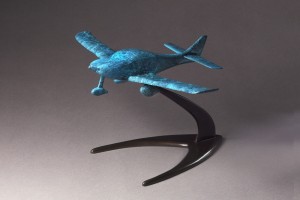
This sculpture, modeled in a dramatic blue marble patina, is fashioned after The New Spirit of St. Louis, the Lancair Columbia 300 that Erik Lindbergh used during his transatlantic flight.
“I haven’t met a woodworker yet who has a big enough shop,” Lindbergh said. “It’s too small, but you’d be amazed what I can do with such little space, just by moving pieces around. Most of my tools are on wheels, so I can shuttle them into corners. I have three outdoor storage sheds for collected wood.”
Lindbergh’s own hands create every piece, but he does work occasionally with fellow artist Steve Hanners, who helps him with more repetitive work, like sanding.
“It helps a lot, because my joints are still a little hammered,” Lindbergh said. “Steve is very talented. Sometimes he sees things I don’t, and we can bounce ideas off each other. I’ve always enjoyed collaborating with other artists. It’s a great way to learn and see through the eyes of others.”
While his early furniture pieces mostly maintained the driftwood’s original form, Lindbergh has since learned new techniques to coax the essence of sculptures from the wood.
“I was at it for many years before I started doing sculptures that are entirely carved, with nothing left of the original shape of the wood,” he said. “Those are, in essence, subtractive carvings. It took me a long time to get to that point.”
One of his recent achievements is his “Twisted Bronze Lamp,” a warm and unique functioning lamp that has since been cast in a limited edition of just 25 signed copies.
“I find some of the most extraordinary wood,” he explained. “The juniper that eventually became this lamp was one of the most interesting. It looks like Swedish bread dough, full of little wormholes. Once the lamp was complete, I couldn’t bear to let it go, so I bronzed it.”
Lindbergh said that it turned out so well, it still looked like wood.
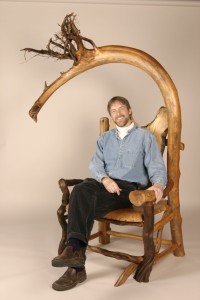
Erik Lindbergh shows off his “Dragon Throne,” a chair made from cedar, locust, holly, juniper and pine.
“Bronze is expensive, so I wanted people to realize that this was a heavy and substantial bronze piece,” he explained. “I eased the patina back with a scouring pad; now, you can see the gleam of the metal coming out. It was a funny process.”
Back to the future
Perhaps Lindbergh’s most evocative pieces, outside of his adaptations of “The Spirit of St. Louis,” are his rustic rocket ships, which have evolved through several different iterations. They include the “Time Capsule Rocket Ship,” which includes a removable plug for artifacts; the “Desktop Rocket,” a science fiction inspired retro rocket; and “Escape from Grey Matter,” a rocket made from several different woods that recently graced the cover of Sculptural Pursuit magazine.
“I started with very abstract, asymmetrical rockets,” Lindbergh recalled. “One day I carved this huge Flash Gordon-style rocket that I pulled from my childhood memories of Flash and Buck Rogers and Emperor Ming. I didn’t look at any pictures; I just pulled it out of my subconscious. It was buried in there with old television shows I saw and books I read when I was a kid. I think it taps into that 1960s romance with space travel.”
Slowly, the rockets have evolved into a fascinating combination of futuristic aesthetics and rustic materials.
“It took several years,” the artist remembered. “I added antennae on top that are aerodynamically improbable, but quite fantastic. They look cool. The original ‘Time Capsule Rocket’ had bolt holes in it, because it came across the Pacific as a yacht cradle. I inlaid a door and portholes in a dark, contrasting wood and added the fins.”
The rockets have been so successful that they’ve led Lindbergh to the new art of bronze casting. Six miniatures of his rockets were the first bronze sculptures to fly into space, courtesy of the X PRIZE-winning SpaceShipOne. The large “Time Capsule Rocket” will be used as the Pete Conrad Spirit of Innovation Award, an X PRIZE initiative that will reward the public’s choice as best spacecraft design. Lindbergh is also being courted to allow the “Desktop Rocket” to be used as a major prize in the television industry.
“The rockets bring tremendous emotional reactions,” he said.
“The Spirit of St. Louis” inspired Lindbergh to create seven sculptures. The most recent is “Evolution of Spirit,” which signifies equilibrium between technology and ecological responsibility.
“That sculpture probably holds the most meaning for me,” he said. “It’s part bird and part plane. It really evokes that mission of balance that my grandparents supported and that the Lindbergh Foundation continues to uphold. We’re right on the fulcrum of that balance between technology and environment. It’s at that point where quality of life is measured. You can’t forsake the technology that comes in the future, but we need to use it in a manner that you don’t forsake the environment. It’s critical to life.”
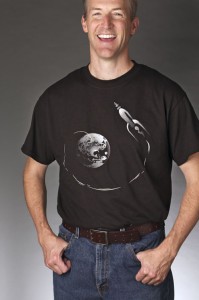
Though he doesn’t often dabble in two-dimensional art, Erik Lindbergh created this “Embryonic Escape” T-shirt, which he says represents our collective human potential.
While the original “Evolution of Spirit” is still for sale, a bronzed version is used as the Lindbergh Award, annually given to leaders who demonstrate the values championed by Charles and Anne Morrow Lindbergh. This year’s award ceremony will be held May 16 in Minneapolis and will honor the work of J. Michael Fay, conservationist, biologist and pilot.
Also available are signed, limited editions of several aircraft sculptures, including a Socata TBM 700 and the Lancair Columbia 300, which is modeled after “The New Spirit of St. Louis.”
“I fly in fits and starts,” Lindbergh admitted. “I decided to carve the planes that I’ve flown. The Columbia is the plane I flew across the Atlantic. The majority of my flight time is in the TBM, which I would love to fly more.”
One of his more interesting pieces is also the largest. Lindbergh is currently seeking a home for his “Floatplane Cradle,” a massive airplane model that is actually a working child’s cradle. Once that piece finds a home, he’ll have much more space in his workshop.
“It’s a huge piece,” Lindbergh said of the cradle. “It weighs about 400 pounds and is highly polished. It turned out to be a fantastic piece of work, but I haven’t sold it yet. I’m trying to figure out how to sell, trade or possibly donate it. It needs to go someplace like a science museum, where kids can get their hands on it.”
The Lindbergh name
Due to his talent and hard work, Lindbergh has come into his own as an artist extraordinaire. But his famous surname doesn’t always mean customers beat down the door.
“Unfortunately, the whole Lindbergh fame thing doesn’t translate into tons of customers,” he said. “I still have to make artwork that appeals to people and charge a fair amount. I don’t do this kind of work for pennies, but I’m busy enough with other projects.”
Lindbergh continues walking the beach, picking up stray bits of driftwood, rescuing the rockets and other amazing subjects within.
“I’m a quarter-time artist right now,” he said. “I think I’d love to do it half-time, but right now, the balance between my two worlds is ideal. I’ll never stop being an artist, because it’s such an integral part of who I am.”
For more information about Erik Lindbergh’s artwork, visit the Lindbergh Gallery at [http://www.lindberghgallery.com]. For more information on Lindbergh’s philanthropic work and public speaking engagements, visit [http://www.eriklindbergh.com]. To learn more about the Charles A. and Anne Morrow Lindbergh Foundation, visit [http://www.lindberghfoundation.org].











